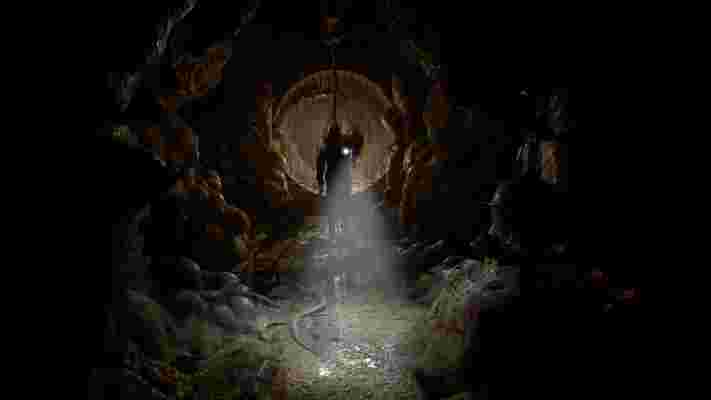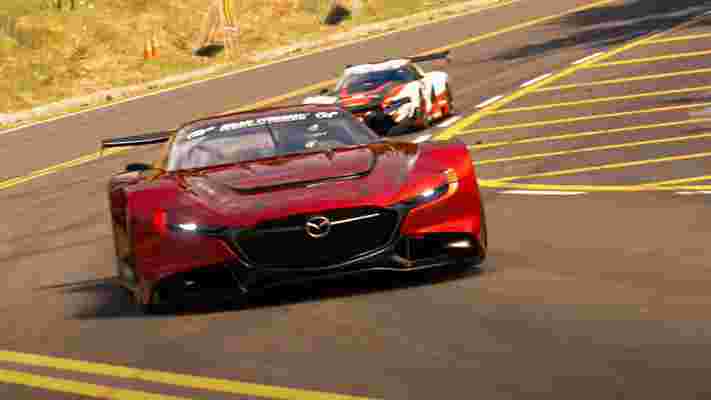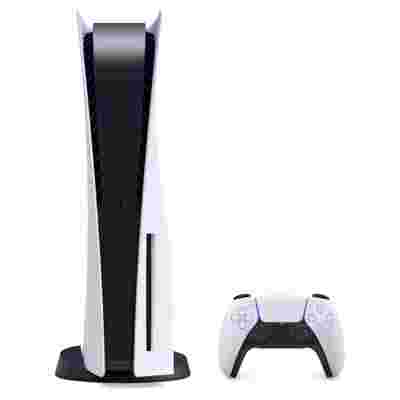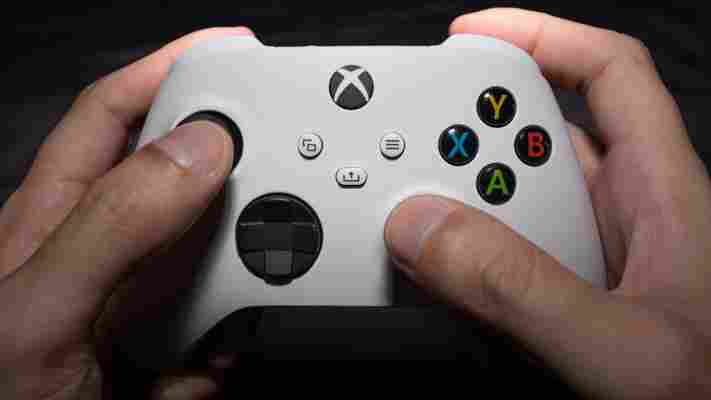PSVR 2, Sony's next-generation of virtual reality on PS5 , is officially on the way. While PSVR 2 was officially announced in 2021, with only a glimpse of the PSVR 2 controllers revealed, Sony has now confirmed that its next-gen VR is called PlayStation VR 2 and will be accompanied by the PlayStation VR 2 Sense controller . According to Sony, this new hardware will boast high-fidelity visuals, new sensory features, and enhanced tracking.
In addition to the reveal of PSVR 2, Sony also announced its first PSVR 2 game: Horizon Call of the Mountain. Being developed by Guerrilla Games and Firesprite, Horizon Call of the Mountain is a VR spin-off of the popular PlayStation Horizon series that will see us venturing into the wilds once more in a brand-new adventure.
But what other games can we expect to take advantage of PSVR 2? While we don't know exactly when we'll get our hands on Sony's next-gen VR, there are plenty of upcoming VR games that are poised to take advantage of the new hardware. Below, we've rounded up the PSVR 2 games which have been confirmed so far as well as those we suspect will make their way to PlayStation VR 2. But make sure to check back here, as we'll be updating this list as more PSVR 2 games are confirmed.
Horizon Call of the Mountain
Horizon Call of the Mountain is the first, and only, confirmed PSVR 2 game so far. Being developed by Guerrilla and Firesprite Games, Horizon Call of the Mountain is set to be a brand new experience set in the world of PlayStation's popular Horizon series.
Built for PSVR 2, Horizon Call of the Mountain will be told through the eyes of a brand new protagonist - though Aloy and other familiar faces from the series will make appearances.
In a PlayStation Blog post , Guerrilla's Studio Director Jan-Bart van Beek wrote that Horizon Call of the Mountain is "designed to push hardware technology, innovation, and gameplay" while "the stunning visuals and brand-new PS VR2 Sense controllers give a new meaning to being fully immersed into the world of Horizon."
Currently, Horizon Call of the Mountain doesn't have a release date, but we expect it will act as a launch title for PSVR 2 (which currently doesn't have a launch date).
Below, we've rounded up a list of upcoming PSVR games that we expect to have PSVR 2 compatibility. It's worth noting Sony has not confirmed any of these titles for PSVR 2 at the time of writing.
Half-Life: Alyx

Out of all the rumored PSVR 2 games on the horizon, Half-Life: Alyx is the one that looks the most likely right now.
According to XboxEra co-founder and co-host Nick "Shpeshal" Baker on Twitter , Sony and Half-Life developer Valve made a deal to bring this critically-acclaimed VR game to PSVR 2. Baker has described the deal as an "open secret" but has admitted he's unsure about when we could see Alyx arriving on Sony's next-gen VR hardware. Currently Half-Life: Alyx is a PC exclusive, only compatible with the Valve Index or Oculus Quest.
While neither Sony nor Valve has confirmed this, we're inclined to believe Baker's claim. The industry insider has accurately leaked information before (particularly about PlayStation), previously revealing that Insomniac Games was working on another Marvel PS5 exclusive ( Wolverine ) and the PS Plus games lineup for May 2021 before either had officially been announced.
Zenith: The Last City
Zenith: The Last City is an anime-inspired MMO set generations after a cataclysmic event known as The Fracture. Alongside others, players will harness the power of Essence to become increasingly powerful and battle to prevent the Fracture from happening again.
RamenVR's upcoming title is set to combine a colorful, fantasy open-world with action RPG gameplay, creating an immersive online VR MMO that sounds like it would be perfect for PSVR 2.
Right now, Zenith is confirmed for PSVR, with a release date to be confirmed. We could see the release date being pushed to accompany the launch of PSVR 2, allowing the power of Sony's next-gen hardware to be showcased in a vibrant open-world.
Moss Book II
Moss is already one of the best PSVR games around, so we fully expect its sequel, Moss: Book II, to be equally (if not more) impressive.
Moss sees you playing as a heroic mouse called Quill who, in the first game, was on a quest to save both her kingdom and her uncle from a fire-breathing snake. Moss: Book II picks up right where the first game left off, and sees Quill being hunted by a winged tyrant and its forces.
Moss: Book II is releasing for PSVR in "Spring 2022" but, given we expect PSVR 2 to likely release at the tail end of this year, it's almost certain that this sequel will have PSVR 2 compatibility - especially given the success of the first game.
Among Us VR
Revealed at The Game Awards 2021 , Among Us VR looks to make the popular social deduction game even more immersive when it lands in 2022.
Right now, Among Us VR is confirmed for PlayStation VR, but, like Moss: Book II, we can't see this new VR game not having PSVR 2 support. While PSVR 2 support won't come at launch if Among Us releases before PlayStation VR 2, we expect support will roll out pretty swiftly after the new hardware's launch.
Gran Turismo 7

Given the success of Gran Turismo Sport VR, we wouldn't be surprised to see the upcoming Gran Turismo 7 land on PSVR 2 at launch - in fact, it sounds like a strong possibility.
Back in 2021, Gran Turismo series creator Kazunori Yamauchi revealed that, when it comes to harnessing the power of next-gen consoles, Gran Turismo 7 developer Polyphony Digital's focus is primarily on VR.
“The first thing that’s going to be affected by more power is VR,” Yamauchi told GT Planet . “I don’t think that there’s anything else that requires that much processing power. I really like VR; I’m one to believe in the possibilities of it, and it’s very suited for a driving game.”
Gran Turismo 7 is set to launch in March, and PSVR 2 likely won't be until the end of the year, giving time for VR support to be implemented for the hardware's launch.
Resident Evil Village

Like Gran Turismo, the Resident Evil series has found success in VR. Both Resident Evil 7 and Resident Evil 4 VR are considered among the best VR games, with virtual reality adding an extra horrifying layer to games that already create plenty of palpable tension.
So it would make perfect sense for the latest Resi entry, Resident Evil Village , to get VR support for PSVR 2. After all, the PS5 version of the game has already shown how 3D audio and haptic feedback add to the horror immersion.
Hitman 3
Hitman 3 VR's arrival on PSVR 2 makes sense from a practical point of view. At present Hitman 3 VR is available on PSVR but it isn't supported on PS5. That means that you can only play it on PS4 or the PS4 version on PS5 - but it is a bit of a hassle to get it working on PS5.
It would make sense, then, for a PSVR 2 version of Hitman 3 VR to be released, making it easier for PS5 owners to access Hitman 3's VR support.
No Man's Sky
Like Hitman 3 VR, No Man's Sky VR only works on PS5 via backwards compatibility. But, given it's also one of the best PSVR games available, we think it deserves much more than that.
We would love to see No Man's Sky VR given PSVR 2 support, allowing it to take advantage of the improved visual fidelity, new sensory features and eye-tracking which the PSVR 2 looks to offer.
No Man's Sky VR's world is already vibrant and stunning, but PSVR 2 has the potential to make them even better - and that's something we would love to see.
HDMI 2.1 TV: why the new cable standard matters
HDMI 2.1 is a new standard of HDMI. It might not sound exciting, but the implications of HDMI 2.1 are huge and the improvements to your viewing experience are already here, shaking up the way many people watch TV shows, movies and play games.
Until recently very few TVs and displays had HDMI 2.1 capability. Granted you still won’t find it everywhere, but now we’re in 2022 it’s becoming much more standard and HDMI 2.1 ports are built into many of the best TVs of 2022.
The reason why HDMI 2.1 is such a game-changing new development is because it works by allowing more information to pass between games consoles , AV receivers , TVs and other devices.
What that means for viewers is they’ll get to see a significant upgrade in the resolution and refresh rate of their TV or display. In other words, pictures are more detailed, images are sharper and games look better in pretty much every way. This is why many people (the team at TechRadar included) think HDMI 2.1 is already beginning to transform entertainment.
Although HDMI 2.1 might be a big deal for every type of screen-based entertainment, including your favorite TV shows and movies, we think you’ll notice the most significant difference in gaming. Especially with the next-gen PS5 and Xbox Series X consoles – if you can find one, that is.

Both of the next-gen games consoles from Sony and Microsoft need an HDMI 2.1 connection to support frame rates up to 120 frames per second (fps). This is far higher than the usual 60fps and 30fps frame rates you’ll see on past games consoles. This is the reason why many TV companies are bringing out new displays that are primed for the future of gaming.
When High Definition Multimedia Interface (or HDMI) first arrived, it shook up the AV industry in a similar way. It was much more practical and convenient to no longer have to use bulky SCART connectors, or confusing component video cables. Instead, HDMI offered high definition video with a connector that was only a little bigger than a standard USB.
There have been many improvements to HDMI over the years since. Extra features are added as the needs of TVs have changed and HDMI 2.1 is the next big step.
The headline feature for HDMI 2.1 is support for 8K content at 60fps. However, there are many smaller features that add up to a much more capable standard, including support for Variable Refresh Rate ( VRR ), Dynamic HDR , and Quick Media Switching, which should make it faster than ever to change between the devices attached to your television.
The big elephant in the room here is that it was revealed in December 2021 that many TVs labelled HDMI 2.1 might not come with all of the features you'd expect from HDMI 2.1 . We cover why this is important in this guide, but what you need to know is that just because a TV says it has HDMI 2.1 capabilities doesn't mean it'll do everything you need it to.
Below you’ll find our guide to everything you need to know about HDMI 2.1 and all of the changes that have arrived with this new HDMI standard that is already shaking up TV, movies and gaming for the better.
When is HDMI 2.1 not HDMI 2.1?
But wait, here’s where it gets confusing. You’d think any devices labelled with HDMI 2.1 would have the high-end features that come with it, right? Like dynamic HDR, variable refresh rate and auto low latency mode, as well as 4K video passthrough at 120Hz? Not so fast.
As reported by Ars Technica in late 2021, many HDMI 2.1 capable devices might not actually have these high-end features after all . Apparently that's thanks to a quirk in the official HDMI guidelines – it turns out that the spec for HDMI 2.0 has been wholly replaced by HDMI 2.1, instead of simply building upon it.
What that means is that manufacturers can choose to solely support a handful of HDMI 2.0 features and label them as HDMI 2.1, given they're still technically a subset of full HDMI 2.1 capability. But the result is that an HDMI 2.1 TV , or the HDMI cables used to connect to one, may not support everything that the average shopper thinks it does.
Ideally, the guidelines will be adjusted to allow for a proper distinction between HDMI 2.0 and HDMI 2.1, not just to prevent further confusion, but also to stop sneaky manufacturers from claiming their products are HDMI 2.1, when they're cherrypicking older specs instead.
But, until then, consumers need to look beyond whether a TV is labelled HDMI 2.1 or not and keep an eye out for other features. This is tricky and involves a lot of looking at specs and comparing displays.
HDMI 2.1 resolution and refresh rates

The new HDMI 2.1 cables allow faster refresh rates. This includes 8K resolution video at 60 frames per second and 4K at 120 frames per second – and it's that second feature that's a real selling point for both gamers and home cinema geeks who want content to look as good as it possibly can.
"We've increased resolutions and frame rates significantly," Jeff Park, Director of Marketing at HDMI Licensing, told TechRadar, adding that "NHK [Japan's national public broadcaster] is going to push 8K120 as an actual broadcast stream, and many consumer electronics manufacturers want to hit that target, so we're laying the pipe to give the industry flexibility. It's practical stuff."
HDMI 2.1 can go even further, supporting resolutions as high as 10K at 120Hz – though that kind of capability isn't here yet and isn't supported on commercial sets.
HDMI 2.1: a saviour for gaming?

HDMI 2.1 might have the biggest impact on the world of gaming. Especially if you have a next-gen games console, like the PS5 or Xbox Series X. Both of these new consoles must have a TV that supports HDMI 2.1 to work properly.
That's because HDMI 2.1 covers a number of technologies, including capability for 4K gaming at 120Hz, or 8K gaming at 60Hz – both of which are visually impressive if you have the hardware and cables to support them.
8K gaming is a while off still, but HDMI 2.1 means you soon won't have to choose between 4K resolution and high refresh rates, being able to experience both together.
HDMI 2.1 also enabled VRR (variable refresh rate), which helps to keep games looking smooth by switching up the refresh rate on the fly to best suit how much is happening onscreen. That means less image lag, stutter and frame tearing similar to the effect achieved by FreeSync and G-Sync.
This is great news for gamers, because HDMI 2.1 enables a 3D graphics processor to render and display images in real time, which will result in more fluid gameplay and greater detail.
HDMI 2.1: what is eARC?
It's not all about TVs, either; soundbars, AV amplifiers and other audio equipment also benefit from HDMI 2.1 – though it will mean upgrading all of your equipment.
For the last few generations, HDMI cables have had an Audio Return Channel (ARC), which means audio can be sent both ways between a TV and audio gear. This essentially enables a display to send its own audio – perhaps from a built-in Netflix app – to a soundbar or surround sound system, bypassing its own speakers.
Enhanced Audio Return Channel (eARC) is nothing more than a simple update to keep pace with changes in audio codecs, specifically to include the new object-based audio codecs, Dolby Atmos and DTS:X .
"eARC ups the bandwidth significantly,” says Park. “Previously you were limited to two-channel PCM or legacy Dolby Digital or DTS audio, but with eARC that reverse channel can now support much higher bandwidth audio including Dolby True HD, DTS HD, Dolby Atmos, DTS:X and other object-based audio at much higher bandwidths."
HDMI 2.1: what is a 48G cable?
This is about defining a new specification of a HDMI cable's speed, with so-called 48G cables (for now just a working title) offering 48Gbps bandwidth for sending uncompressed 8K video, with HDR, over a HDMI 2.1 cable.
So why do we need a 48G-rated cable? "Because we're carrying so much data now – we've gone from 18Gbps in HDMI 2.0 to 48Gbps in HDMI 2.1," says Park. "Today we have 'standard speed' and 'high speed' HDMI cables, and 48G will be related to that."
Ditto the compliance tests that each HDMI 2.1 cable will have to pass in order to be labelled as such. Backwards-compatible with earlier versions of the HDMI specification, and able to be used with existing HDMI devices.
HDMI 2.0 cables are all really the same, despite what some manufacturers will try to tell you with their branding – but an HDMI 2.1 cable with 48Gbps will be necessary to experience the technology's capabilities, and you'll need a compatible HDMI 2.1 port on any connecting hardware (TVs, soundbars) too.
HDMI 2.1 TV: what screens are out there?
Now we're in 2022, HDMI 2.1 has become much more commonplace. But 2021 is the year it went mainstream. Before that it only received piecemeal support on a handful of high-end sets, often with only one HDMI 2.1 port with two or three HDMI 2.0 ports alongside.
That's still the case with some manufacturers (the Sony A90J OLED features a mix of 2.1 and 2.0 inputs), while others are going all-in on HDMI 2.1 ports on their premium TV ranges. Both LG and Samsung are in this latter camp, and you can expect up to four HDMI 2.1 ports on select sets, especially the new TVs for 2022 .
There are some solid options from last year from Sony if you're looking for HDMI 2.1 ports, like the Sony X90J , a native 120Hz TV with two full-spec HDMI 2.1 ports for the Xbox Series X and PS5.
When it comes to Samsung, you'll find HMDI 2.1 in a handful of sets from last year, which includes the Samsung QN85A , and Samsung QN90A Neo QLED TV . But again, HDMI 2.1 will be available in more of Samsung's TVs for 2022.
Other brands have HDMI 2.1 options as well, including the TCL 6-Series 2021 8K QLED TV and the Vizio P-Series Quantum X.
Jamie Carter originally contributed to this article.
Google Docs will now really let you stamp your mark on your work
Making sure your work gets the respect it deserves will soon be a lot easier in Google Docs thanks to a new privacy tool coming to the service.
The word processor tool, part of Google Workspace , has announced users can now add background text identifiers such as watermarks to their documents.
This means that Google Docs users can now mark their work in order to protect copyright, show that the information within is confidential, or simply notify readers that it is a draft or work in progress.
Google Docs watermark
In a blog post outlining the new feature, Google notes that text watermarks will repeat on every page on your document, making it useful for indicating file status.
Users can also include an image watermark, such as a company logo or sign, or include other images above or behind text. To find the new feature, which has no admin control, users simply need to go to Insert > Watermark > Text .
The feature will work across other platforms too, as when working with Microsoft Word documents, text watermarks will be preserved when importing or exporting your files.

The tool will be available to all Google Workspace customers, as well as G Suite Basic and Business customers, with the rollout starting in January 2022 and due to take a few weeks.
The news should be a boost to legal and high-end businesses dealing in confidential documents, and comes shortly after a further new functionality also looked to add greater depth to Docs that sees a new process for formal document approvals for high-priority files (such as contracts, legal documents and the like), building upon existing comment and suggested edit features.
Google Docs has also recently boosted its citations feature, making the software a more viable choice for students and academics. When adding a citation to an essay or research paper, users will soon be able to search for sources via an in-built database, and then automatically populate the necessary fields (title, publisher, date of publication etc.).